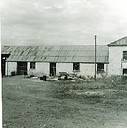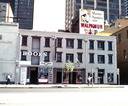National Trust Database - Search Results |
Back to search page » | |
| Displaying 1- 10 of 11 records found |
| Image | Name | Detail | File number | Level |
|---|---|---|---|---|

|
Heape Court Warehouses - Group Classification
Cooper's Warehouse
,
Pynsent's First Store
,
Pynsent's Second Store
303 - 305 Elizabeth Street & 359 - 365 Little Lonsdale Street,, MELBOURNE VIC 3000 - Property No B6125 |
Heape Court Warehouses, dating from the early 1850s,is an important surviving examples of a nineteenth century commercial laneway precinct. It contains two rare examples of gold-rush period warehouses, the 1854 brick Pynsent's Second Store and Cooper's Blacksmith Shop at the rear of 361-5 Little Lonsdale Street, and the 1853 bluestone Pynsent's First Store at 303-305 Elizabeth Street constructed by the notable firm of James Lawrence & son. The laneway also contains the ... more |
B6125 |
State |
|
60 - 66 Harware Street,, MELBOURNE VIC 3000 - Property No B6577 |
A group of three warehouses dating from c.1890 which, together with others in Hardware Street, indicate the intensive warehousing acitivity in the late 19th century in this quarter of Melbourne. Classified: 06/06/1994 |
B6577 |
Regional | |

|
29 Kavanagh Street,, SOUTHBANK VIC 3006 - Property No B6089 |
A collection of relatively plain, simple, gable-ended brick warehouses first constructed in 1893. This is the best preserved of the free storage facilities constructed in South Melbourne towards the end of the nineteenth century, and has been associated with three of the major activities in the area: the river trade, the paper industry, and the performing arts. Classified: 24/07/1989 Revised: October 1989 |
B6089 |
State |

|
23 - 31 Niagara Lane,, MELBOURNE VIC 3000 - Property No B4430 |
A group of four three-storey brick warehouses in extremely original and intact condition. Designed by G. De Lacy Evans and built by Daniel Sinclair for Mrs. M. Marks in 1887. The high Dutch gabled facade incorporates American barrel hoists which are still in operation. Classified: 08/02/1979 Revised: 03/08/1998 |
B4430 |
State |

|
2 and 3 (also known as 30) Oliver Lane,, MELBOURNE VIC 3000 - Property No B7005 |
The warehouses at 2 & 3 Oliver Lane in Melbourne, completed in 1907 and probably designed by noted engineer John Monash, and built by noted builder David Mitchell, are of historical and architectural significance at the State level. They are historically important as they appear to be the first conventional buildings in Australia constructed almost wholly of reinforced concrete. They are also significant for their associations with their designer and builder, whose offices ... more |
B7005 |
State |
|
Former Griffiths Brothers Tea Warehouses
Hotel Lindrum
26 - 30 Flinders Street, MELBOURNE VIC 3000 - Property No B4410 |
B4410 |
File only | ||

|
Warehouse - Port Fairy & Rosebrook Flour Mill / Cheese & Butter Factory
Port Fairy Aquarium
,
Steam Packet Wharf/ warehouse
37 Gipps Street,, PORT FAIRY VIC 3284 - Property No B0859 |
This building comprises the remains of the quite extensive wharf warehouses constructed by Belfast & Koroit Steam Navigation Company on the banks of the River Moyne. The stone building housing the aquarium was built c.1849 for Alison & Knight flour millers & prominent businessmen and landowners in the early years of Port Fairy. In 1868, it was absorbed into Captain Lewis Grant's 'Steam Packet Wharf'. The office section fronting Gipps Street was built for Grant in ... more |
B0859 |
Local |

|
376 - 380 Flinders Street,, MELBOURNE VIC 3000 - Property No B5118 |
Erected in 1853 as a speculative development by Messrs.Chambers and Brown, the contractor was George Chambers. The three identical three-storey stone warehouses also have a frontage to a rear laneway. They are important survivors of the era in Melbourne's early history when shipping gathered in 'The Pool of Melbourne' directly opposite the Customs House. Few buildings dating from these early times remain to bear witness to what was once the important maritime area of Melbourne. ... more |
B5118 |
Demolished |

|
Gippsland & Northern Store
Cnr Robbs & Flinders Lanes,, MELBOURNE VIC 3000 - Property No B0832 |
Demolished: prior to November 1981 |
B0832 |
Demolished |
|
578 - 584 Bourke Street, MELBOURNE VIC 3000 - Property No B4111 |
Built c.1893. Demolished c.1983. |
B4111 |
Demolished |
| 1 2 | next |
